The workplace is full of risks especially when it comes to manual handling and manual labour. While you might think that your workplace is safe and that employees are responsible, you cannot take this approach for granted. A problem can arise in no time at all and before you know it, your business is being investigated and you find yourself facing either criminal or civil action.
However, there is one way to avoid these risks and issues which is to ensure you are aware of regulations and do everything possible to make sure your workplace and practices are as safe as possible.
The Manual Handling Operations Regulations 1992 amended 2002
The main thing to realise is that there are specific regulations that you need to follow in order to remain compliant with both criminal and civil laws. The regulations clearly state what is expected of employers and how they can keep employees safe.
The Manual Handling Operations Regulations were released in 1992 but were further amended in 2002 to include a wide range of manual handling activities which includes the likes of carrying, pulling, lowering, pushing and lifting.
Furthermore, when it comes to working from height, there are many risks and responsibilities involved. However, it’s important to recognise that employers are responsible for manual handling regulations. As a result, they must provide relevant information on the correct manual handling techniques while all equipment has to be fit for purpose and maintained correctly.
With all that said, employees do have responsibilities too and that means that they have to use equipment correctly and safely while they have to follow safe systems of work. It is also an expectation that they work with employers on health and safety matters and inform them of any manual handling risks.
Regulations Governing the Use of Work Equipment
Whether it’s working from height or providing equipment to aid lifting, the Provision and Use of Work Equipment Regulations 1998 are designed to place the responsibility onto businesses and organisations that own, use and operate work equipment. As a result, it’s imperative that you recognise the importance of ensuring that all equipment is fit for purpose.
The equipment has to be suitable for the intended use which means that it has to meet all relevant standards, in addition to this, you will also need to make sure that it is safe to use and that you maintain it regularly. Staff that have not had training are not permitted to use this, therefore, you will need to make sure that all correct training is provided. Finally, you will also need to implement any relevant health and safety measures which can include the likes of safety measures and all necessary signage.
It might seem as though there is a lot to think about when it comes to manual labour, handling and using equipment. However, with many risks to consider, it is vital that you keep up to speed with the regulations to ensure you are aligned with any changes.


